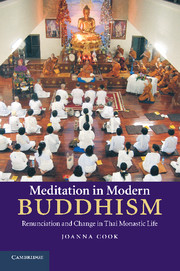Book contents
- Frontmatter
- Contents
- Acknowledgements
- List of map and figures
- Notes on language
- Map 1 Map of Thailand
- 1 Meditation and monasticism: making the ascetic self in Thailand
- 2 Meditation and religious reform
- 3 The monastic community: duty and structure
- 4 Meditation as ethical imperative
- 5 Language and meditation
- 6 Monastic duty, mindfulness and cognitive space
- 7 Money, mae chee and reciprocity
- 8 Hierarchy, gender and mindfulness
- 9 Monasticization and the ascetic interiority of non-self
- Appendix: Ordination transcript for an eight-precept nun (mae chee)
- Bibliography
- Index
9 - Monasticization and the ascetic interiority of non-self
Published online by Cambridge University Press: 03 May 2011
- Frontmatter
- Contents
- Acknowledgements
- List of map and figures
- Notes on language
- Map 1 Map of Thailand
- 1 Meditation and monasticism: making the ascetic self in Thailand
- 2 Meditation and religious reform
- 3 The monastic community: duty and structure
- 4 Meditation as ethical imperative
- 5 Language and meditation
- 6 Monastic duty, mindfulness and cognitive space
- 7 Money, mae chee and reciprocity
- 8 Hierarchy, gender and mindfulness
- 9 Monasticization and the ascetic interiority of non-self
- Appendix: Ordination transcript for an eight-precept nun (mae chee)
- Bibliography
- Index
Summary
We have seen in the foregoing that while monastic identity and ascetic practices such as vipassanā meditation have historically been the preserve of monks, requiring full ordination and celibacy, this is not the case in contemporary Thailand. Furthermore, ‘monastic’ and ‘lay’ have never been uncomplicated or mutually exclusive categories in the Thai context.
I have argued that the involvement of mae chee in teaching and practising meditation is leading to the incorporation of women in religious and monastic roles; mae chee in Wat Bonamron are able to define themselves and be defined by others as monastics. As we saw in Chapter 8, there are different ways in which the office of ‘mae chee’ is being understood and enacted in the broader context of the Thai religious landscape. We have also seen, however, that mae chee remain hierarchically inferior to monks, as evidenced by spatial separation between men and women in the monastery. Mae chee do not make claims to the monastic office of monkhood and understand their demonstrable respect for monks (as paragons of religious professionalism) to be meritorious.
While ideas about pollution and separation are clearly visible in the monastery there are ways in which they are balanced by the identity held by both monks and mae chee of ‘ordinand’ (nak buat).
- Type
- Chapter
- Information
- Meditation in Modern BuddhismRenunciation and Change in Thai Monastic Life, pp. 173 - 194Publisher: Cambridge University PressPrint publication year: 2010



